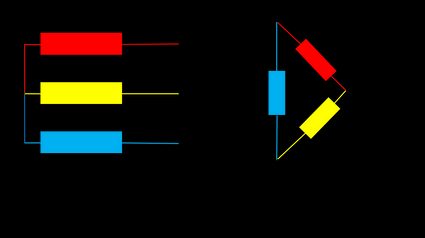Watts to Amps Calculator
This watts to amps calculator (also known as amps to watts calculator or amperage calculator) helps you understand how to calculate watts of a circuit depending on the type of the current. Read on to find out how to convert watts to amps or vice versa and learn about the differences between line-to-line and line-to-neutral voltage configurations applied to three-phase currents.
The convention of using watts, amps, and volts
When talking about the fundamental Ohm's law, we consider a few physical quantities: resistance R, voltage V, and amperage I. Electric current can also be a source of power P so that it can release or transport some energy. The SI unit of voltage is a volt, the unit of amperage is an ampere (usually shortened to amp), and the unit of power is a watt.
All of these units from volts and amps to watts describe the voltage, amperage, and power respectively since they are shorter and easier to be pronounced. This convention is commonly used in the electronic world, so whenever you hear that somebody wants to convert amps to watts or watts to amps, you will know that the person wants to find the relation between the amperage and electric power.
How to convert watts to amps or amps to watts?
In fact, this question is not precise enough - you should ask: "How to convert volts and amps to watts?" To answer it, you'll first need to know what kind of current you're dealing with. We can distinguish three main types of amperage:
- DC current,
- AC - Single-phase current,
- AC - Three-phase current, which can be further subdivided, depending on the system configuration, into:
- Delta connection - referring to Line-to-Line Voltage (VLL),
- Star connection - referring to Line-to-Neutral Voltage (VLN).
The only thing we have to do is to choose the specific formulas which convert watts to amps for any type of flowing current. They are described in detail in the next section.
How to calculate watts?
The formula for DC watts to amps is a well-known expression used in the electrical power calculator:
I = P / V.
The expression used for AC single-phase current, which can be represented as a sine-wave signal (you can see its shape in the sin calculator), is very similar:
I = P / (V * PF),
where PF is a power factor. It tells us about the ratio between the real power, which does the work, and the one supplied to the circuit. It varies from 0 to 1. The values close to unity are usually obtained for resistive-only loads, whereas the occurrence of capacities, or especially inductances, lowers this value. You can read more about this quantity in the power factor calculator.
The formula for AC three-phase current changes by a constant factor, as follows:
I = P / (√3 * V * PF)for line-to-line voltage,I = P / (3 * V * PF)for line-to-neutral voltage.
How to use the watts to amps calculator?
Let's see how this amperage calculator works in practice. Imagine that we want to know the power of a current with 15 amps and a three-phase alternating current, line-to-neutral voltage, with the amplitude of 100 volts (in other words, what is the result of conversion 15 amps to watts for VLN equal 100 volts). We assume the power factor to be of the value 0.9.
- Firstly, rewrite the initial watts to amps formula into the amps to watts equation:
P = 3 * V * PH * I, - As long as all of the values have desired units, simply input them into the formula:
P = 3 * 100 V * 0.9 * 15 A = 4050 W, - The outcome can be expressed as: "15 amps to watts, for the VLN equal to 100 volts is 4050 W."
If you are uncertain about the result, just use our watts to amps calculator, pick the appropriate current type, insert all values, and check if there is any discrepancy. If you are correct, there shouldn't be one!
The difference between line-to-line and line-to-neutral voltages
A three-phase current is usually applied in the electricity networks that are connected to our houses. Three-phase means that there are three distinct wires, each of which conducts the same signal but at a different phase. There is also another wire of neutral potential, referring to the ground. The potential difference between any two cables is always higher than between any wire and neutral one. At the receiving end, all of these wires are joined together, and their configuration can be implemented in two ways, a star configuration or a delta configuration, which are shown in the following diagram:

The difference in the end connection results in different output power, which is the reason why you should choose the appropriate option of three-phase voltage in our watts to amps calculator.
By the way, you can always control the value of the voltage you want to deliver to your devices. If it turns out that the signal is too high, it's worth implementing some kind of voltage divider in order to reduce it. You can find more information about them in the voltage divider calculator.